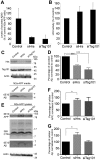ESCRTs regulate amyloid precursor protein sorting in multivesicular bodies and intracellular amyloid-β accumulation
- PMID: 26002056
- PMCID: PMC4510853
- DOI: 10.1242/jcs.170233
ESCRTs regulate amyloid precursor protein sorting in multivesicular bodies and intracellular amyloid-β accumulation
Abstract
Intracellular amyloid-β (Aβ) accumulation is a key feature of early Alzheimer's disease and precedes the appearance of Aβ in extracellular plaques. Aβ is generated through proteolytic processing of amyloid precursor protein (APP), but the intracellular site of Aβ production is unclear. APP has been localized to multivesicular bodies (MVBs) where sorting of APP onto intraluminal vesicles (ILVs) could promote amyloidogenic processing, or reduce Aβ production or accumulation by sorting APP and processing products to lysosomes for degradation. Here, we show that APP localizes to the ILVs of a subset of MVBs that also traffic EGF receptor (EGFR), and that it is delivered to lysosomes for degradation. Depletion of the endosomal sorting complexes required for transport (ESCRT) components, Hrs (also known as Hgs) or Tsg101, inhibited targeting of APP to ILVs and the subsequent delivery to lysosomes, and led to increased intracellular Aβ accumulation. This was accompanied by dramatically decreased Aβ secretion. Thus, the early ESCRT machinery has a dual role in limiting intracellular Aβ accumulation through targeting of APP and processing products to the lysosome for degradation, and promoting Aβ secretion.
Keywords: Alzheimer's disease; Amyloid precursor protein; ESCRT; Multivesicular body.
© 2015. Published by The Company of Biologists Ltd.
Conflict of interest statement
The authors declare no competing or financial interests.
Figures






References
-
- Buxbaum J. D., Gandy S. E., Cicchetti P., Ehrlich M. E., Czernik A. J., Fracasso R. P., Ramabhadran T. V., Unterbeck A. J. and Greengard P. (1990). Processing of Alzheimer beta/A4 amyloid precursor protein: modulation by agents that regulate protein phosphorylation. Proc. Natl. Acad. Sci. USA 87, 6003-6006. 10.1073/pnas.87.15.6003 - DOI - PMC - PubMed
Publication types
MeSH terms
Substances
Grants and funding
LinkOut - more resources
Full Text Sources
Other Literature Sources
Medical
Molecular Biology Databases
Research Materials
Miscellaneous

